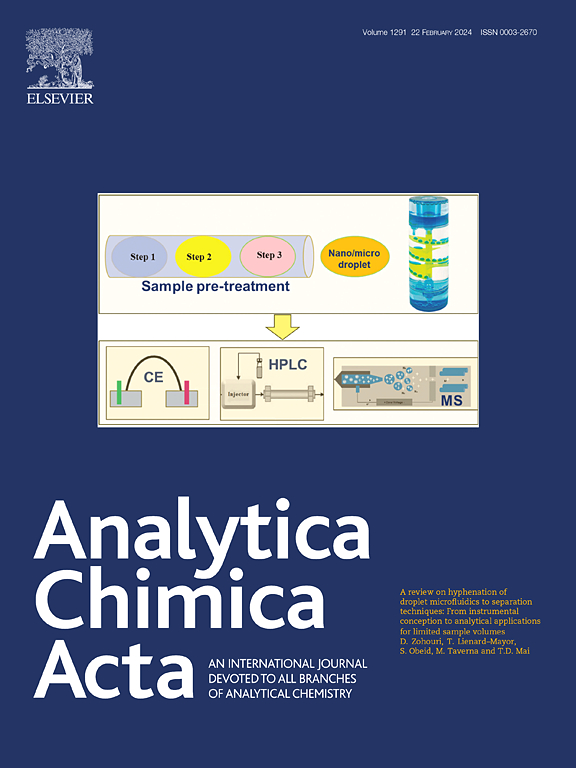有机光电化学晶体管检测毒死蜱的分子螯合和屏蔽操作
IF 6
2区 化学
Q1 CHEMISTRY, ANALYTICAL
引用次数: 0
摘要
毒死蜱(Chlorpyrifos, CPF)作为防治害虫的四大杀虫剂之一,广泛应用于农业生产中,但其持续积累对环境造成了严重污染。在本文中,我们开发了一种新型的有机光电电化学晶体管(OPECT)传感器,用于使用BiOI@Bi2S3光门进行CPF检测。CPF与表面Bi(III)离子的分子螯合会引起屏蔽效应,改变OPECT响应。在零偏置电压下具有较高的电流增益,开发的OPECT装置能够灵敏和特异性地检测CPF,线性范围为1×10-4-1×102 ng mL-1,检测限(S/N=3)为0.032 pg mL-1。同时,对水样、生菜和苹果中的CPF进行了OPECT检测,样品的回收率为94.6% ~ 103.1%,相对标准偏差(RSD)为1.51% ~ 4.26%。本文报道了一种新的OPECT检测CPF的策略,揭示了OPECT检测其他有机磷农药的潜力。本文章由计算机程序翻译,如有差异,请以英文原文为准。


Molecular chelating and shielding operation for organic photoelectrochemical transistor detection of chlorpyrifos
Chlorpyrifos (CPF), as one of the four major insecticides for pest control, is widely used in agricultural production, but its continuous accumulation has caused serious pollution to the environment. In this paper, we developed a novel organic photoelectrochemical transistor (OPECT) sensor for the CPF detection using a BiOI@Bi2S3 photogate. The molecular chelating of CPF with surface Bi(III) ions would induce the shielding effect that altered the OPECT response. With a high current gain at zero bias voltage, the as-developed OPECT device was able to detect CPF sensitively and specifically with a linear range of 1 × 10−4-1 × 102 ng mL−1 and a detection limit (S/N = 3) of 0.03 pg mL−1. Meanwhile, the OPECT detection of CPF in water samples, lettuce and apple were also conducted, with the recoveries of 94.6%–103.1 % and the relative standard deviations (RSD) of 1.51%–4.26 % for the samples. This work reports a new OPECT strategy for CPF detection, which reveals the potential of OPECT for detecting other organophosphorus pesticides.
求助全文
通过发布文献求助,成功后即可免费获取论文全文。
去求助
来源期刊

Analytica Chimica Acta
化学-分析化学
CiteScore
10.40
自引率
6.50%
发文量
1081
审稿时长
38 days
期刊介绍:
Analytica Chimica Acta has an open access mirror journal Analytica Chimica Acta: X, sharing the same aims and scope, editorial team, submission system and rigorous peer review.
Analytica Chimica Acta provides a forum for the rapid publication of original research, and critical, comprehensive reviews dealing with all aspects of fundamental and applied modern analytical chemistry. The journal welcomes the submission of research papers which report studies concerning the development of new and significant analytical methodologies. In determining the suitability of submitted articles for publication, particular scrutiny will be placed on the degree of novelty and impact of the research and the extent to which it adds to the existing body of knowledge in analytical chemistry.
 求助内容:
求助内容: 应助结果提醒方式:
应助结果提醒方式:


